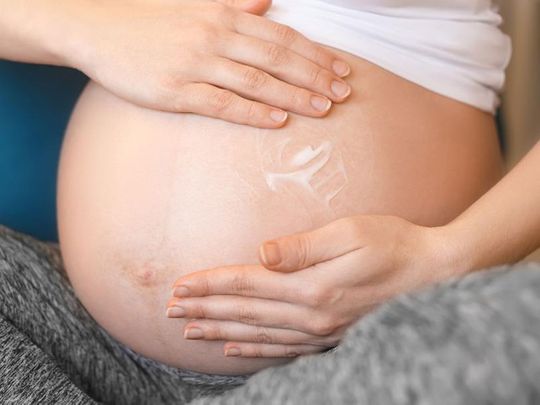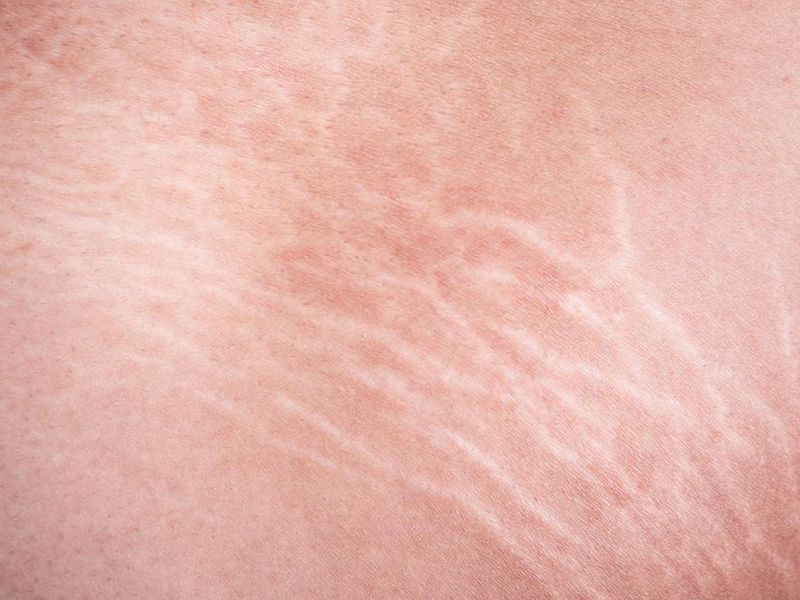
They’re a sign that you’ve done something amazing, a reminder of your part in one of the most magical possible human experiences. They’re harmless, painless and not really all that noticeable. But are they unavoidable?
We spoke to Dr Hala Mohammad, dermatology specialist at Mediclinic in Dubai, for the lowdown on the whys, the whens and the how-to-avoids of stretch marks in pregnancy…
What are stretch marks?
“Stretch marks are small, depressed streaks in the skin that appear most often on the abdomen in the later stages of pregnancy when the belly is rapidly expanding to accommodate a growing baby,” says Dr Mohammad. “Some women also get them on their buttocks, thighs, hips, and breasts.”
Caused by changes in the elastic supportive tissue that lies just beneath the skin, stretch marks happen when the interlinked fibres that allow your skin to expand as you grow are stretched too quickly, and tear. These tears mean that the deeper skin layers show through, creating the stretch marks we all know and (maybe don’t) love.
The blood vessels show through at first - which is why stretch marks start off red, red/brown, purple or dark brown, depending on your skin tone – and then when the blood vessels contract the pale fat underneath your skin will be visible instead, changing the stretch marks change to a paler, beige/silver/grey colour..
Will I get them?
“It's hard to predict who will get stretch marks,” says Dr Mohammad. “At least half of all pregnant women get stretch marks, but no one can tell with certainty who's going to get them and who won't.”
However, Dr Mohammad adds that there are some factors that increase your chances:
“Research suggests that genetics plays a role: If your mother or sister got stretch marks during pregnancy, you're more likely to get them, too. In addition, the more your skin has to expand during pregnancy and the more quickly it happens, the more likely you are to develop stretch marks. For this reason, you're more likely to get stretch marks if:
• You gain a lot of weight rapidly
• You're carrying multiples
• You have excess amniotic fluid
“In addition, darker-skinned women are less likely to have stretch marks than those who are fair-skinned (plus they're not as visible on dark skin).”

What can I do to prevent stretch marks?
There is no definitive way of avoiding stretch marks, says Dr Mohammad.
However, there aare a few things you can do to try to reduce your risk of getting them...
Watch your weight gain
“Gaining no more than the recommended amount of weight and gaining it slowly may reduce your chances of getting stretch marks,” says Dr Mohammad. “Keep an eye on that scale during pregnancy and try to follow the general recommendations for caloric intake during pregnancy.”
Keep moisturized
“There's no proof that any of the creams and oils that claim to prevent stretch marks actually work,” says Dr Mohammad.
"However, keeping your belly well moisturised as it grows may reduce itching.”
Hydrate
Moisturise from the inside with lots of water, which is advisable in pregnancy anyway.
Nourish your skin from the inside
Plenty of vitamin C foods in your pregnancy diet may also help keep your skin toned and less subject to stretch marks.
How can I treat stretch marks?
The best time to treat the marks, is while they're still in that reddish stage, says Dr Mohammad. She suggests the following options for treating stretch marks:
- Gels made with hyaluronic acid
- Topical glycolic acid creams
- Using a retinoid. This speeds up cell turnover and can stimulate new collagen growth, leading to plumper, healthier skin. However, you can’t use a retinoid if you’re pregnant or breastfeeding
- Lasers that heat the skin. These cans stimulate collagen growth and shrink dilated blood vessels. It may take a number of sessions to see results
- Gentler processes such as dermabrasion can also help renew the skin
- Carboxy therapy, which is injection of co2 gas subcutaneously, is of value
- Plasma injections can also stimulate collagen
Stretch marks tend to fade over time, but if you’re really self-conscious about them one option is to use camouflage make-up to disguise them. However, the best option in our opinion is to wear those tiger stripes with pride!
Read more:








